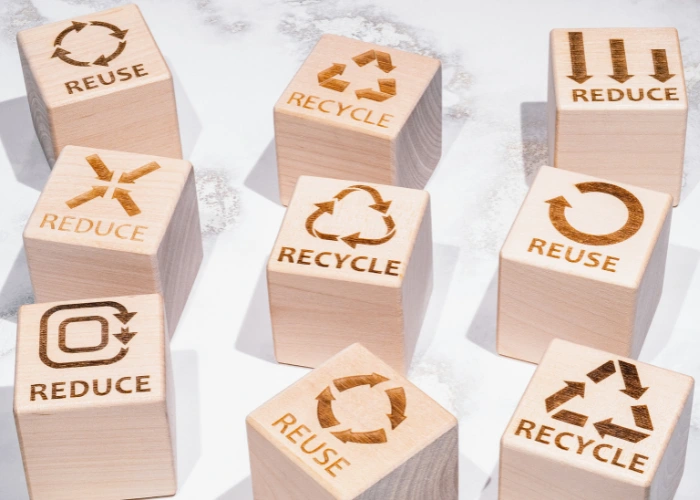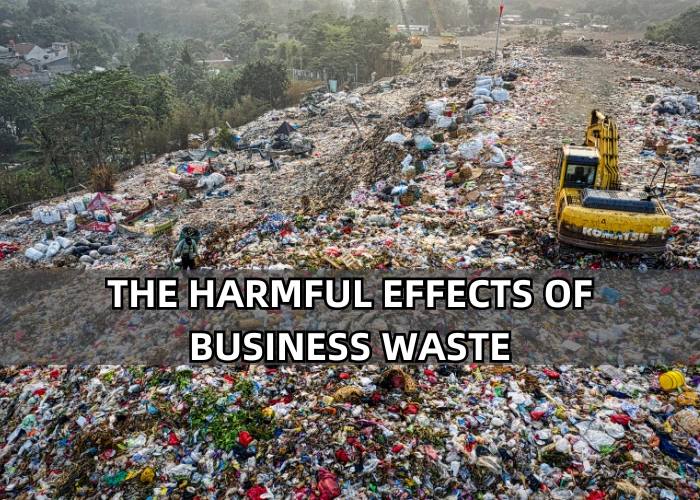Have you ever thought about how much waste you create each day? Stop and think about it for a moment—packaged goods, disposable goods, food wastes, and even used electronics. We’re always heading to the trash bin to get rid of something. But just how much waste is it? Well, it turns out it’s about 4.9 pounds per person. That’s a lot of trash heading to our landfills, taking up precious space on our earth.
Those statistics? Most of that trash that we’re talking about above comes at home. But what happens at work? Businesses tend to create a lot of waste, from excess printing to packaging and so much more. So, what can you do ro create less waste in your organization? We have some ideas for you.
The Harmful Effects of Business Waste
Business waste does more harm than we think. Every bit of waste, big or small, affects our planet. Think about it—when companies throw away paper, plastic, or electronics, these don’t just disappear. They end up in landfills, piling up over time. This takes up a lot of space on Earth that could be used for nature or to grow food.
Not just that, but some waste is really bad for the air and water. Chemicals from thrown-away products can leak into the ground. This pollutes our water, harming fish and wildlife. It also makes the water unsafe for us to drink. Plus, when waste breaks down, it releases gasses like methane. Methane is a greenhouse gas, much worse than carbon dioxide. It traps heat in our atmosphere, causing the planet to get warmer. This leads to climate change, which can cause extreme weather, hurt crops, and lead to less food for everyone.
How to Reduce Waste in Your Organization
At EMCI Wireless, we have the privilege of helping organizations all over central and southern Florida to solve their communication problems. We’re a top distributor of Motorola two-way radio systems. Through all of these business relationships, we get the opportunity to learn about what they’re doing to make the world a better place. We thought we’d take the time to pass some of those insights along to you.
1. Conduct a Waste Audit
Conducting a waste audit is like taking a deep dive into what your organization throws away. It’s about discovering the types of waste you generate, identifying items that could have been recycled but weren’t, and understanding the decisions behind purchasing and management that lead to waste. During an audit, you might be surprised by what you find—things you didn’t expect to be part of your waste stream.
The process involves reviewing how waste can be reduced and how more materials can be recycled. This means deciding on the right bins, systems, and training needed to make recycling easier and more effective in your workplace.
2. Measuring How Much Waste Your Organization Produces
Measuring the amount of waste your organization produces is a must for managing and reducing it. You can measure waste by volume or weight, tracking how much is collected over a certain period. Different types of audits provide insights into what is being thrown away.
For instance, you can sort through trash to identify recyclable items being lost or set up temporary bins for specific materials. This is especially useful for tracking food waste or materials not currently recycled. It helps you understand the composition of your waste, identify disposal challenges, and tailor recycling programs to your organization’s specific needs.

3. Digitize
Digitizing is a powerful way to cut down on paper waste. Options like electronic documents, cloud storage, and digital forms replace the need for printed materials. Organizations can significantly reduce their environmental footprint by moving to a digital workspace.
Integrating technology like Motorola’s MOTOTRBO digital two-way radio systems into your organization’s tech infrastructure supports this shift. MOTOTRBO enhances communication, ensuring smooth operations as you transition to digital processes. Additionally, these systems are designed with future-proofing in mind. Maximizing the lifetime of your two-way radio system through regular updates and scalable solutions ensures your investment continues to meet your needs as technology evolves.
4. Eliminate Single-Use Materials
We all need to do our part to reduce waste. A great place to start is by cutting down on single-use materials. These are items we use once and then throw away, which fill our landfills and pollute our environment. By identifying and eliminating these materials from our daily operations, we can significantly impact our ecological footprint.
Here are some common single-use materials to consider:
- Plastic utensils and straws
- Disposable cups and plates
- Paper towels and napkins
- Plastic water bottles
- Packaging materials, such as shrink wrap and bubble wrap
- Single-use coffee pods
- Plastic bags
5. Create a Clear Waste Management Strategy
Any organization committed to reducing its environmental impact must create a clear waste management strategy. Such a strategy should outline specific waste reduction, handling, recycling, and disposal procedures. This clarity ensures that every team member understands their role in minimizing waste.
A comprehensive waste management strategy should include:
- Waste Audit Results: Understanding what waste is produced and how.
- Goals for Waste Reduction: Setting specific targets to minimize waste generation.
- Recycling Protocols: Guidelines on recycling processes and materials.
- Plans for Hazardous Waste: Handling and disposing of dangerous materials safely.
- Importance of Communication: Ensuring protocols are followed through effective communication.
- Advanced Communication Tools: Utilizing technologies such as EMCI Wireless two-way radio systems for real-time coordination and updates on waste management practices.
6. Regularly Reassess Waste Production and Management Strategies
Regularly reassess waste production and management strategies to adapt to changing business operations, technological advancements, and environmental standards. Continuously monitoring waste outputs helps identify inefficiencies and areas for improvement.
For example, a manufacturing company may find its waste management practices outdated due to introducing new, more sustainable materials and processes. By reassessing their strategies, they can adjust their recycling protocols to include these new materials, significantly reducing their environmental impact.
7. Incentivize Waste Reduction
Incentivizing waste reduction within an organization can significantly enhance participation and commitment to sustainability goals. Here are several ways to encourage waste reduction:
- Recognition Programs: Acknowledge departments or teams that achieve waste reduction targets. Helpful hint: Skip the paper certificates and focus on digital awards such as online gift cards or experiences.
- Employee Engagement: Involve employees in brainstorming sessions for waste reduction ideas. When employees are part of the solution, they’re more likely to participate and buy-in..
- Monetary Incentives: Offer bonuses or other financial rewards for suggestions that lead to measurable waste reduction.
- Competitions: Organize challenges between departments to see who can reduce the most waste, with prizes for the winners.
- Training and Education: Provide resources and training on reducing waste and recycling, empowering employees with the knowledge to make sustainable choices.
- Resource Accessibility: Make it easy for employees to reduce waste by providing reusable items, recycling bins, and composting facilities.

8. Make Eco-Friendly Business Partnerships
Partnering with eco-friendly businesses ensures that sustainability efforts extend beyond the confines of your immediate operations. When every link in the supply chain prioritizes waste reduction, it leads to a significant cumulative effect.
Such partnerships also respond to increasing consumer demand for environmentally responsible products and services. This can improve your brand reputation and competitive advantage.
EMCI Wireless is Here to Help You Digitize Your Communications
If you’re ready to take the bull by the horns and reduce waste in your organization, don’t forget that digitizing your communications should be part of your strategy. At EMCI Wireless, we’re here to help. As a leading Motorola solutions partner, we have the expertise to help get you set up with the right infrastructure. Request a free consultation today.






